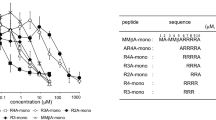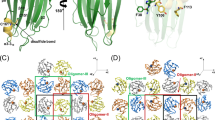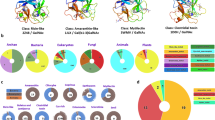Abstract
We describe a library of two-chain molecular complementation mutants of staphylococcal α-hemolysin that features a combinatorial cassette encoding thousands of protease recognition sites in the central pore-forming domain. The cassette is flanked by a peptide extension that inactivates the protein. We screened the library to identify α-hemolysins that are highly susceptible to activation by cathepsin B, a protease that is secreted by certain metastatic tumor cells. Toxins obtained by this procedure should be useful for the permeabilization of malignant cells thereby leading directly to cell death or permitting destruction of the cells with drugs that are normally membrane impermeant.
This is a preview of subscription content, access via your institution
Access options
Subscribe to this journal
Receive 12 print issues and online access
$209.00 per year
only $17.42 per issue
Buy this article
- Purchase on Springer Link
- Instant access to full article PDF
Prices may be subject to local taxes which are calculated during checkout
Similar content being viewed by others
References
Bhakdi, S. and Tranum-Jensen, J. 1991. Alpha-toxin of Staphylococcus aureus . Microbiol. Rev. 55: 733–751.
Gouaux, J.E., Braha, O., Hobaugh, M.R., Song, L., Cheley, S., Shustak, C., and Bayley, H. 1994. Subunit stoichiometry of staphylococcal α-hemolysin in crystals and on membranes: a heptameric transmembrane pore. Proc. Natl. Acad. Sci. USA 91: 12828–12831.
Ward, R.J., Palmer, M., Leonard, K., and Bhakdi, S. 1994. Identification of a putative membrane-inserted segment in the α-toxin of Staphylococcus aureus . Biochemistry 33: 7477–7484.
Walker, B., Kasianowicz, J., Krishnasastry, M., and Bayley, H. 1994. A pore-forming protein with a metal-actuated switch. Protein Eng. 7: 655–662.
Valeva, A., Weisser, A., Walker, B., Kehoe, M., Bayley, H., Bhakdi, S., and Palmer, M. 1996. Molecular architecture of a toxin pore: a 15-residue sequence lines the transmembrane channel of staphylococcal alpha-toxin. EMBO J. 15: 1857–1864.
Bayley, H. 1995. Pore-forming proteins with built-in triggers and switches. Bioorg. Chem. 23: 340–345.
Walker, B.J. and Bayley, H. 1994. A pore-forming protein with a protease-activated trigger. Protein Eng. 7: 91–97.
Sloane, B.F., Dunn, J.R., and Honn, K.V. 1981. Lysosomal cathepsin B: correlation with metastatic potential. Science 212: 1151–1153.
Recklies, A.D., Poole, A.R., and Mort, J.S. 1982. A cysteine protease secreted from human breast tumours is immunologically related to cathepsin B. Biochem. J. 207: 633–636.
Keppler, D., Abrahamson, M., and Sordat, B. 1994. Secretion of cathepsin B and tumour invasion. Biochem. Soc. Trans. 22: 43–49.
Schwartz, M.K. 1995. Tissue cathepsins as tumor markers. Clin. Chim. Acta 237: 67–78.
Kobayashi, H., Schmitt, M., Goretzki, L., Chucholowski, N., Calvete, J., Kramer, M., Günzler, W.A., Jänicke, F., and Graeff, H. 1991. Cathepsin B efficiently activates the soluble and the tumor cell receptor-bound form of the proenzyme urokinase-type plasminogen activator (pro-uPA). J. Biol. Chem. 266: 5147–5152.
Arkin, A.P. and Youvan, D.C. 1992. Optimizing nucleotide mixtures to encode specific subsets of amino acids for semi-random mutagenesis. Biotechnology 10: 297–300.
Johnson, B.H. and Hecht, M.H. 1994. Recombinant proteins can be isolated from E. coli cells by repeated cycles of freezing and thawing. Biotechnology 12: 1357–1360.
Barrett, A.J. and Kirschke, H. 1981. Cathepsin B, cathepsin H, and cathepsin L. Methods Enzymol. 80: 535–561.
Khouri, H.E., Plouffe, C., Hasnain, S., Hirama, T., Storer, A.C., and Ménard, R. 1991. A model to explain the pH-dependent specificity of cathepsin B-catalysed hydrolyses. Biochem. J. 275: 751–757.
Ullman, D. and Jakubke, H.-D. 1994. The specificity of clostripain from Clostridium histolyticum. Mapping the S′ subsites via acyl transfer to amino acids. Eur. J. Biochem. 223: 865–872.
Ménard, R., Carmona, E., Plouffe, C., Brömme, D., Konishi, Y., Lefebvre, J., and Storer, A.C. 1993. The specificity of the S1′ subsite of cysteine proteases. FEBS Lett. 328: 107–110.
Taralp, A., Kaplan, H., Sytwu, I.-I., Vlattas, I., Bohacek, R., Knap, A.K., Hirama, T., Huber, and Hasnain, S. 1995. Characterization of the S3 subsite specificity of cathepsin B. J. Biol. Chem. 270: 18036–18043.
Musil, D., Zucic, D., Turk, D., Engh, R.A., Mayr, I., Huber, R., Popovic, T., Turk, V., Towatari, T., Katunuma, N., and Bode, W. 1991. The refined 2.15Å X-ray crystal structure of human liver cathepsin B: the structural basis for its specificity. EMBO J. 10: 2321–2330.
Matthews, D.J. and Wells, J.A. 1993. Substrate phage: selection of protease substrates by monovalent phage display. Science 260: 1113–1117.
Schellenberger, V., Turck, C.W., Hedstrom, L., and Rutter, W.J. 1993. Mapping the S′ subsites of serine proteases using acyl transfer to mixtures of peptide nucleophiles. Biochemistry 32: 4349–4353.
Panchal, R.G. and Bayley, H. 1995. Interactions between residues in staphylococcal α-hemolysin revealed by reversion mutagenesis. J. Biol. Chem. 270: 23072–23076.
Barrett, A.J. 1973. Human cathepsin B1. Purification and some properties of the enzyme. Biochem. J. 131: 809–822.
Walker, B. and Bayley, H. 1995. Key residues for membrane binding, oligomerization, and pore-forming activity of staphylococcal α-hemolysin identified by cysteine scanning mutagenesis and targeted chemical modification. J. Biol. Chem. 270: 23065–23071.
Matrisian, L.M. 1992. The matrix-degrading metalloproteinases. Bioessays 14: 455–463.
Stetler-Stevenson, W.G., Liotta, L.A., and Kleiner, D.E. 1993. Role of matrix metalloproteinases in tumor invasion and metastasis. FASEB J. 7: 1434–1441.
Huennekens, F.M. 1994. Tumor targeting: activation of prodrugs by enzyme-monoclonal antibody conjugates. Trends Biotechnol. 12: 239–245.
Pederzolli, C., Belmonte, G., Serra, M.D., Macek, P., and Menestrina, G. 1995. Biochemical and cytotoxic properties of conjugates of transferrin with equinatoxin II, a cytolysin from a sea anemone. Bioconjugate Chem. 6: 166–173.
Yemul, S., Berger, C., Estabrook, A., Suarez, S., Edelson, R., and Bayley, H. 1987. Selective killing of T lymphocytes by phototoxic liposomes. Proc. Natl. Acad. Sci. USA 84: 246–250.
Walker, B.J., Krishnasastry, M., Zorn, L., Kasianowicz, J.J., and Bayley, H., 1992. Functional expression of the α-hemolysin of Staphylococcus aureus in intact Escherichia coli and in cell lysates. J. Biol. Chem. 267: 10902–10909.
Walker, B.J., Krishnasastry, M., Zorn, L., and Bayley, H. 1992. Assembly of the oligomeric membrane pore formed by staphylococcal α-hemolysin examined by truncation mutagenesis. J. Biol. Chem. 267: 21782–21786.
Huff, J.P., Grant, B.J., Penning, C.A., and Sullivan, K.F. 1990. Optimization of routine transformation of Escherichia coli with plasmid DNA. BioTechniques 9: 570–576.
Chung, C.T., Niemela, S.L., and Miller, R.H. 1989. One-step preparation of competent Escherichia coli: transformation and storage of bacterial cells in the same solution. Proc. Natl. Acad. Sci. USA 86: 2172–2175.
Gilles, A.-M., Imhoff, J.-M., and Keil, B. 1979. α-Clostripain: chemical characterization, activity, and thiol content of the highly active form of clostripain. J. Biol. Chem. 254: 1462–1468.
Author information
Authors and Affiliations
Rights and permissions
About this article
Cite this article
Panchal, R., Cusack, E., Cheley, S. et al. Tumor protease-activated, pore-forming toxins from a combinatorial library. Nat Biotechnol 14, 852–856 (1996). https://doi.org/10.1038/nbt0796-852
Received:
Accepted:
Issue Date:
DOI: https://doi.org/10.1038/nbt0796-852
This article is cited by
-
Oligomerization of the antimicrobial peptide Protegrin-5 in a membrane-mimicking environment. Structural studies by high-resolution NMR spectroscopy
European Biophysics Journal (2017)
-
Molecular dynamics simulation of water permeation through the alpha-hemolysin channel
Journal of Biological Physics (2016)
-
multifunctional enzymes in cancer
Nature Reviews Cancer (2006)
-
Detecting protein analytes that modulate transmembrane movement of a polymer chain within a single protein pore
Nature Biotechnology (2000)
-
Reversible permeabilization of plasma membranes with an engineered switchable pore
Nature Biotechnology (1997)



